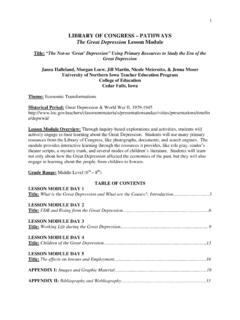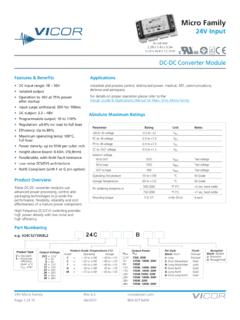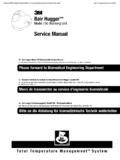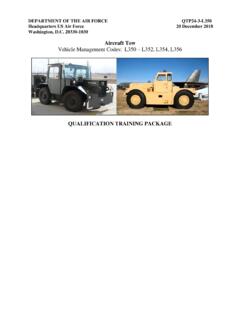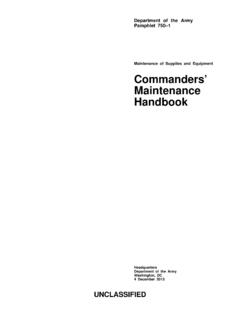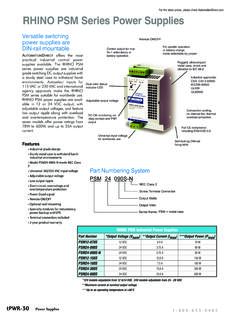Transcription of 60K-Loader Vehicle Management Codes: E945
1 DEPARTMENT OF THE AIR FORCE QTP 24-3-E945. Headquarters US Air Force 27 April 2018. Washington, 20330-1030. 60K-Loader Vehicle Management Codes: E945. QUALIFICATION TRAINING PACKAGE. CONTENTS. SECTION 1 OVERVIEW .. 3. Overview.. 3. SECTION 2 RESPONSIBILITIES .. 3. Responsibilities.. 3. SECTION 3 4. Objectives.. 4. Desired Learning Outcomes.. 4. Lesson Duration.. 5. Instructional References.. 6. Instructional Training Aids and Equipment.. 6. SECTION 4 TRAINEE PREPARATION .. 7. Licensing Requirements.. 7. Required Reading (Testable Material).. 7. SECTION 5 KNOWLEDGE LECTURE AND EVALUATION .. 7. Overview of Training and Requirements.. 7. Vehicle 26. Vehicle Safety and Equipment.
2 34. Driving Safety and Precautions.. 36. Vehicle Operation.. 37. 60K Loader with Series 900 Mercedes Benz Engine.. 49. Tunner (60K) Loader 51. SECTION 6 EXPLANATION AND DEMONSTRATION.. 54. Instructor's Preparation.. 54. Safety Procedures and Equipment.. 54. Operator Maintenance 55. Operation Demonstration.. 55. SECTION 7 TRAINEE PERFORMANCE AND EVALUATION .. 58. Trainee 58. Performance Evaluation.. 60. Attachment 1 GLOSSARY OF REFERENCES AND SUPPORTING INFORMATION 63. Attachment 2 SUBJECT KNOWLEDGE 67. Attachment 3 Vehicle INSPECTION GUIDE 67. Attachment 4 PERFORMANCE TEST 73. Attachment 5 SEVEN-STEP INSPECTION PROCESS 80. Section 1 OVERVIEW. Overview. Send comments and suggested improvements on AF Form 847, Recommendation for Change of Publication through Air Force Installation and Mission Support Center (AFIMSC).
3 Functional managers via e-mail at How to use this plan: Instructor: Provide overview of training, Section 2 and Section 3. Instructor's lesson plan for trainee preparation, give classroom lecture, Section 4. Instructor's lesson plan for knowledge exam, Section 5. Instructor's lesson plan for demonstration, Section 6. Instructor's lesson plan for performance and evaluation, Section 7. Trainee: Reads this entire lesson plan prior to starting lecture. Follows along with lecture using this lesson plan and its attachments. Takes knowledge exam. Uses Attachment 3 and Attachment 5 as guides for Vehicle inspection. Takes performance test. Section 2 RESPONSIBILITIES. Responsibilities.
4 The trainee shall: Ensure the trainer explains the Air Force Qualification Training Package (AFQTP) process and the responsibilities. Review the AFQTP/Module/ unit with the trainer. They trainee should ask questions if he/she does not understand the objectives for each unit . Review missed questions with the trainer. Instructor shall: Review the AFQTP with the trainee. Conduct knowledge training with the trainee using the AFQTP. Grade the review questions using the answer key. Review missed questions with the trainee to ensure the required task knowledge has been gained to complete the task. Sign-off the task(s). The Certifier shall: Evaluate the Airman's task performance without assistance.
5 Sign-off the task(s). Section 3 INTRODUCTION. Objectives. Given lectures, demonstrations, hands-on driving session and a performance and written test, trainees will be able to perform operator's inspection and complete the performance test with zero instructor assists and achieve 80% on the written tests. Train and qualify each trainee in safe operation and preventive maintenance of the 60K-Loader . This training will ensure the trainee becomes a qualified 60K-Loader operator; an operator who has the knowledge and skills to operate a 60K-Loader in a safe and professional manner. Desired Learning Outcomes. Understand the purpose of the 60K-Loader and its role in the mission.
6 Locate information contained in the applicable TO and explain terminology used in the technical manual and operator' guide. Identify the major components and the various operating systems contained on the loader. Identify, inspect and operate the operational subsystems on the loader. Identify components of the deck assembly and explain how they function. Identify and locate linkage and chassis assemblies on the loader. Explain what type of engine is in the loader and how the hydrostatic drive system functions. Identify and operate the controls located inside of the cab. Explain the deck conveyor, pitch, roll and side shift functions. Explain how to remove the side rail assembly, install the deck extension and catwalks, and placement of the bridge plates.
7 Understand the safety precautions to be followed before-, during-, and after- operation of the 60K-Loader . Know the proper operator maintenance procedures of the 60K-Loader , IAW. applicable technical orders (TOs) and use of Air Force (AF) Form 1800, Operator's Inspection Guide and Trouble Report. Safely and proficiently operate the 60K-Loader . Know how to operate the loader in the event of an emergency, and be familiar with how to start the loader during cold weather. Be able to configure the loader for air shipment to include: spinning the bogies, deck and cab reconfiguration, weighting and marking the loader and aircraft loading. Know how to transport the tunner by truck and disengage the hydrostatic drive hubs in the event of a maintenance problem and the loader needs to be towed.
8 Explain where to locate trouble shooting data and how to change a wheel or tire. Lesson Duration. Recommended instructional and hands on training time is 80 hours: Figure Recommended Training Time for Training Activities. Training Activity Training Time Trainee's Preparation 10 Hours Instructor's Lecture 15 Hours Trainee's Written Evaluation 3 Hours Instructor's Demonstration 10 Hours Trainee's Personal Experience (to build confidence and proficiency). 40 Hours Perform Operator Maintenance Operate the Vehicle Trainee's Performance Evaluation 2 Hours Note: This is a recommended time; training time may be more or less depending how quickly a trainee learns new tasks. Instructional References.
9 Risk Management (RM) and Safety Principles. Applicable TOs or Manufacturer's Operator's Manual. See Vehicle Management for TO number for Vehicle being used in training. ( 36M2-3-35-11 and 36M2-3-35- 11CL-1). Air Force Manual (AFMAN) 24-306, Operation of Air Force Government Motor Vehicles, Chapters 1-5 and 7-12. AF Form 1800. Special references based-off type of Vehicle . Hazardous Material Lesson Plan, if applicable. Instructional Training Aids and Equipment. 60K-Loader Lesson Plan. 60K-Loader Overhead Projector Applicable TO or Manufacturer's Operator's Manual. ( 36M2-3-35-11 and 36M2-3-35-11CL-1). AF Form 1800. 60K PowerPoint. Series 900 Loader Training PowerPoint. Videos (if locally produced).
10 Suitable training area. Traffic cones. Section 4 TRAINEE PREPARATION. Licensing Requirements. Trainee must have in his/her possession a valid state driver's license. AF Form 171, Request for Driver's Training and Addition to Government Drivers IAW Air Force Instruction (AFI) 24-301, Vehicle Operations. Applicable local licensing jurisdiction requirements. Required Reading (Testable Material). Read this entire lesson plan. Read AFMAN 24-306, Chapters 1-5 and 7-12. Read Manufacturer's Operator's Manual for the Vehicle being trained on. Section 5 KNOWLEDGE LECTURE AND EVALUATION. Overview of Training and Requirements. Training objectives: Given lectures, demonstrations, hands-on driving session, and a performance and written test, trainees will be able to perform operator's inspection and complete the performance test with zero instructor assists and achieve 80% on the written tests.











